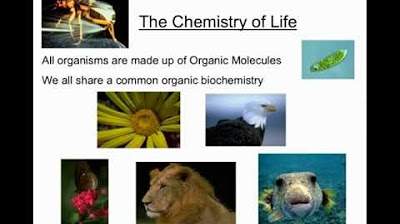Recognizing Functional Groups in Drugs and Medications
Summary
TLDRThis script delves into the world of organic chemistry, focusing on functional groups—the key to understanding molecules' properties and reactivity. It explains how these groups, such as alcohols, ethers, and amines, classify molecules into families and dictate their behavior. The video uses common medications like ibuprofen and morphine to illustrate how specific functional groups contribute to their therapeutic effects, highlighting the profound impact of even minor structural variations on a drug's efficacy and side effects.
Takeaways
- 🧪 Functional groups in organic molecules define their chemical and physical properties, and categorize them into specific families.
- 🔗 Carbon to carbon single bonds are common in hydrocarbons but do not define a molecule's functional group family unless no other functional groups are present.
- 🔑 The presence of a carbon to carbon double bond classifies a molecule as an alkene, while a triple bond places it in the alkyne family.
- 🌐 A six-membered ring with alternating single and double bonds is characteristic of aromatic hydrocarbons, which have distinct properties from alkenes.
- 🍷 Functional groups containing oxygen include alcohols, phenols, ethers, ketones, aldehydes, and carboxylic acids, each with unique properties.
- 🌿 Functional groups with nitrogen include amines and amides, which are essential for various biological activities.
- 💊 Medications like ibuprofen and albuterol have distinct functional groups that contribute to their therapeutic effects and interactions within the body.
- 🔍 Identifying functional groups in drugs involves recognizing heteroatoms and unusual bonding patterns that define their chemical behavior.
- 💡 The structure of a molecule, defined by its functional groups, determines its mechanism of action, as seen in the comparison between aspirin and acetaminophen.
- 🌼 Natural and synthetic molecules can have similar structures but different properties, as demonstrated by the comparison between morphine and codeine.
- 📚 Understanding functional groups is crucial for analyzing the properties and actions of organic compounds, including drugs and medications.
Q & A
What are functional groups in organic chemistry?
-Functional groups in organic chemistry are specific atoms or groups of atoms that provide the molecule with specific chemical and physical properties, classify the molecule into a family, and determine the naming of the molecule.
What are the different types of hydrocarbon families mentioned in the script?
-The different types of hydrocarbon families mentioned are alkanes (with single bonds only), alkenes (with at least one carbon-carbon double bond), alkynes (with at least one carbon-carbon triple bond), and aromatics (with a six-membered ring and alternating single and double bonds).
How do aromatic hydrocarbons differ from alkenes in terms of properties?
-Although aromatic hydrocarbons may appear similar to alkenes in structure, they differ in properties. Aromatic hydrocarbons are more like alkanes in their properties, which is why they are classified into a separate family.
What is the significance of functional groups in the context of medications and drugs?
-Functional groups in medications and drugs determine the reactivity, properties, and the way these substances interact with biological receptors, which is crucial for their therapeutic effects.
How does the presence of a carboxilic acid group influence a molecule's properties?
-A carboxilic acid group, characterized by a carbon double-bonded to oxygen and with a hydroxyl group (OH) attached to the same carbon, imparts acidic properties to the molecule, allowing it to donate a proton (H+).
What is the difference between an ester and a carboxilic acid?
-An ester is a derivative of a carboxilic acid where the hydroxyl group (OH) of the carboxilic acid is replaced by an alkoxy group, while a carboxilic acid has a hydroxyl group attached to the carbon that is also double-bonded to oxygen.
What is the role of the amine functional group in organic molecules?
-The amine functional group, which contains nitrogen bonded to carbons or hydrogens, can participate in various chemical reactions and is often involved in the formation of salts, coordination compounds, and can influence the solubility and basicity of the molecule.
How does the presence of an ether functional group affect a molecule?
-An ether functional group, which consists of an oxygen atom bonded to two carbon atoms, can affect the molecule's polarity, solubility, and can act as a source of steric hindrance in reactions.
What is the structural difference between aceto salicylic acid (aspirin) and aceto minen (Tylenol)?
-Aspirin (aceto salicylic acid) has an ester group and a carboxilic acid group, while Tylenol (aceto minen) has an amide group and lacks the carboxilic acid group, leading to different mechanisms of action and side effects.
How does the structure of procaine relate to that of cocaine?
-Procaine is modeled after the structure of cocaine but with modifications to remove groups that contribute to cocaine's addictiveness. Both contain amide and aromatic groups, but procaine is designed to be a safer local anesthetic.
What is the functional group difference between morphine and codeine that leads to their different properties?
-Morphine has an alcohol group off the aromatic ring, while codeine has an ether group in that position. This small structural difference results in codeine being less potent as a painkiller but having a lower potential for addiction and better cough-suppressing properties.
Outlines

This section is available to paid users only. Please upgrade to access this part.
Upgrade NowMindmap

This section is available to paid users only. Please upgrade to access this part.
Upgrade NowKeywords

This section is available to paid users only. Please upgrade to access this part.
Upgrade NowHighlights

This section is available to paid users only. Please upgrade to access this part.
Upgrade NowTranscripts

This section is available to paid users only. Please upgrade to access this part.
Upgrade NowBrowse More Related Video

Functional groups | Properties of carbon | Biology | Khan Academy

Organic Biochemistry Screencast Session 1.mp4

Functional Groups with Memorization Tips

Clase U12-Fundamentos de Química Orgánica-1° Parte-Alcanos

The Functional Group Concept Explained | Organic Chemistry | FuseSchool

ORGANIC CHEMISTRY explained in 8 Minutes
5.0 / 5 (0 votes)